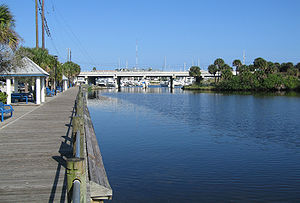- Crane Creek (Melbourne, Florida)
-
Crane Creek 
Crane Creek & Crane Creek PromenadeOrigin Melbourne, Florida Mouth Indian River Basin countries United States Crane Creek is a 3.3-mile-long (5.3 km)[1] stream in Melbourne, Florida, United States. It is a tributary of the Indian River, with its mouth in the vicinity of Front Street.
Contents
History
Evidence for the presence of Paleo-Indians in the Melbourne area during the late Pleistocene epoch was uncovered during the 1920s. C. P. Singleton, a Harvard University zoologist, discovered the bones of a Mammoth (Mammuthus columbi) on his property along Crane Creek, 1.5 miles (2.4 km) from Melbourne, and brought in Amherst College paleontologist Frederick B. Loomis to excavate the skeleton. Loomis found a second elephant, with a "large rough flint instrument"[2] among fragments of the elephant's ribs. Loomis found in the same stratum mammoth, mastodon, horse, ground sloth, tapir, pessary, camel and saber-tooth cat bones, all extinct in Florida since the end of the Pleistocene 10,000 years ago. At a nearby site a human rib and charcoal were found in association with Mylodon, Megalonyx and Chlamytherium (ground sloths) teeth. A finely worked spearpoint found with these items may have been displaced from a later stratum. In 1925 attention shifted to the Melbourne golf course. A crushed human skull with finger, arm and leg bones was found in association with a horse tooth. A piece of ivory that appeared to have been modified by humans was found at the bottom of the stratum containing bones. Other finds included a spear point near a mastodon bone and a turtle-back scraper and a blade found with bear, camel, mastodon, horse and tapir bones.[3] Similar human remains, Pleistocene animals and Paleo-Indian artifacts have been found in the general locale, consistent with these discoveries.
European settlement
Crane Creek greatly influenced the development of the area. Prior to the development of Melbourne, hunters used Crane Creek to gain entrance into the interior.[4] In the mid 1880s, the first pioneers in Melbourne settled in the area around Crane Creek, which became the present day Historic Downtown area on the east end of New Haven Avenue near Front Street.[5]
The settlement was first named "Crane Creek" but was renamed after the American Civil War.
Current development
Florida Institute of Technology's construction development after its establishment in 1958 eventually expanded into Crane Creek. Crane Creek currently runs adjacent to Florida Tech's Student Union Building, Brownlie Hall, as well as Florida Tech's Botanical Gardens.[6]
See also
References
- ^ U.S. Geological Survey. National Hydrography Dataset high-resolution flowline data. The National Map, accessed April 18, 2011
- ^ Purdy:23
- ^ Purdy:23-9
- ^ Scofner, Jerrell H. History of Brevard County Volume I (Stuart, FL: Brevard County Historical Commission, 1995), p. 90.
- ^ Stone, Elaine Murray. Brevard County (Northbridge, CA: Windsor Publications, Inc., 1988), p. 29.
- ^ Fact Card
Coordinates: 28°04′19″N 80°37′10″W / 28.0718773°N 80.6195645°W
Categories:- Melbourne, Florida
- Rivers of Florida
- Landforms of Brevard County, Florida
Wikimedia Foundation. 2010.
